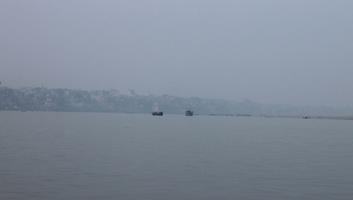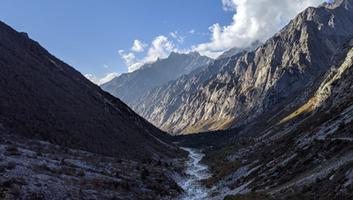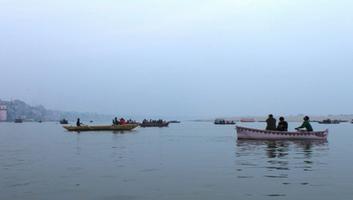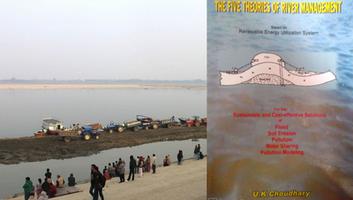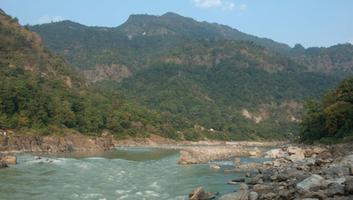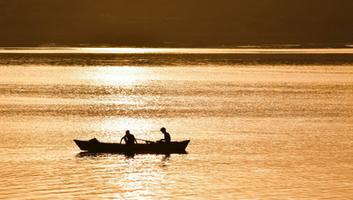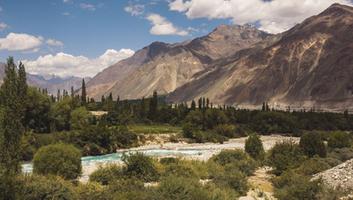Ganga Nadi - Ganga, our soul
- By
- VK Joshi
- August-13-2018
I still vividly remember that evening of 1968, when
as a young geologist , I was loitering on the road on the Shimla Ridge. The sky
kissing Cedar trees loomed large over my traverse. There was a particular tree
with a bill board, which read, ‘You are standing on the water divide between
the Indus and the Ganga Rivers. All water on the south of this ridge flows into
the Ganges and finally reaches the Bay of Bengal; and water on the north of
this ridge flows into the Arabian Sea, via the Indus.’ After reading that
notice, I stared at the road, the surface of which was slightly raised in the
middle. As I pondered over it, I saw a tiny hump of tar on this slight
convexity in the middle of the road. I realized that a tiny drop of dew falling
on this blob of tar must be getting divided to reach two separate seas or
rather two separate politically controlled countries!
In the nature, I felt that each and every drop of
water is thus accounted for and since that day, to know more about the Ganga
and its tributaries became a passion for me. I became curious to know how tiny
droplets of water must have formed the mighty Ganga and how the river must have
become sacrosanct to the Hindus!
As our ancestors evolved from a hunter gatherer to
cultivator stage they preferred to settle on the river banks. All major
civilizations of the World were borne, proliferated and ultimately perished on
the river banks. In our Asian subcontinent, the Indus Valley Civilization is a
classic example. The downfall of the Indus Valley Civilization, led to the rise
of the Ganga Valley Civilization. We north Indians are the occupants of the
various tracts of land on the banks of this mighty river.
The River Ganga has been enigmatic to me ever since
long. There is an anecdote related to this fascination. A dip in a river
purifies the soul is a common belief. Hindus believe that a dip in the Ganga
takes them to the heaven after death. In the Christianity a person is baptized
with water from the Jordan River. Jordan means ‘the giver’ and Ganga means the
one which flows. Both the rivers are much revered. The humanity and the rivers
have been connected with each other since times immemorial.
It will not be incorrect to say that ‘today’s India
is a gift of the Ganga.’ If Ganga was not there, the fertile plains of north
India would not have been there. Look at the geographical map of this part of
Asia, look at the points of origin of the great rivers Indus, Ganga and
Brahmaputra. Indus and Brahmaputra originate from different slopes of Mount
Kailash and flow in two different directions. Indus at Nanga Parvat and
Brahmaputra near Namche Barwa take a southerly turn. Is this just a coincidence
or the creator’s will or the nature’s way of giving respect to the holy Ganga?
Indus and Brahmaputra which seem to hold the Himalayas or the gigantic tresses
of Lord Shiva, like a ribbon. As per the mythology after getting entangled in
the tresses of the Lord Shiva the force of the mighty Ganga was reduced enough
to make it flow through the valleys towards the plains!
My readers may be wondering, why a geologist is
taking us for a ride and spinning a yarn of mythology about the Character and
qualities of the holy river? There is a reason for that. Actually the era in
which the story of Ganga was written the term science had not evolved. Thus, in
order to convince the man these myths were created to make him understand the
sanctity of the river or for that matter, water. That is why I am also taking
help from the mythology to explain you the might of the Ganga.
Ganga is not just a faith of the Hindu religion, it
is a source of life for the people of all the religions and all forms of life.
Our ancestors knew the significance of water very well. They called it ‘विश्व्भेषजं’, or
‘made of medicines.’ In our mythology, Ganga emerged out of the toe nail of
Lord Vishnu and resided in the “kamandal’ of Brahma in the heavens. Kapil muni
ignorantly burnt sixty thousand sons of Raja Sagar of Ikshvaku dynasty. It was
said, if the Ganga descends to the earth and the ashes of these sixty thousand
dead are washed in it, their souls will get peace. In order to achieve that the
grandson of Sagar, Anshuman penanced throughout his life, but Brahma could not
be pleased. After his death, pleased with the penance of his son Bhagirath,
Lord Brahma opened the mouth of his ‘Kamandal.’
The descent of Ganga has been beautifully described
by Ravan in his Shivatandavstrotam as follows:
‘कोऽपिधारयितावेगंपतन्त्यामेंमहीतले।
अन्यथाभूतलंभित्त्वानृपयास्येरसातलम्।।
-नवमस्कन्ध
Ganga warns Bhagirath, “O, king, if I land directly
on the earth, my force is such that I will straightaway reach the ‘Pataal.’
Kindly pray to Lord Shiva to open his tresses to bear the shock of my descent.
And thereafter I promise to follow you all along.” She followed him through the
labyrinths of Lord Shiva, which are the Himalayas to Ganga Sagar. She has been
doing so, since then…
Well that was the mythical narrative of the descent
of Ganga, as per the belief of the Hindus. The fact is that Ganga is India’s
longest (2525km) river. It is the third longest river in the world and has a catchment
of 1060000 sq.km. The total area of this catchment is spread from the southern
slopes of the Himalayas to the northern limit of the Indian subcontinent,
covering a total surface area of 26.2%. About 80% of the Ganga catchment is
spread over the Indian subcontinent and rest is in Nepal, China and Bangladesh.
Now, let us scientifically peep into the past of the
earth. Some 20 million years ago, where the Himalayas are situated, used to be
a gigantic ocean, the Tethys Sea. The Indian plate came floating on the surface
of this Sea like a Noah’s Arc and collided with the Asian Plate. So powerful
was the collision, that the world’s youngest and loftiest mountains, the
Himalayas were born. The outcome of this collision was that the geography of
this region was rewritten. Consequently, the north flowing rivers like Chambal
and its tributaries had to take a southern trend. Even today before meeting the
Yamuna, the Chambal flows north and suddenly takes a U turn. The newly emerging
rivers from the Himalayas, that is Indus and Ganga began flowing south-west and
south-east respectively.
The nature, which we presume that we are ruling upon
has given us wonderful treasures, but we are bent upon plundering them. If the
Himalayas were not there, we would not have been here, because the freezing
winds from Tibet would have made our sub-continent a deep freeze. It is only
because of the Himalayas, that we have monsoons, which make the rivers carry
more and more silt and loam and spread them layer by layer on the plains after
floods succeeding the rains. This action of the rivers enriched the soil and
made these plains the most fertile plains. Because of fertility these areas
like U.P. and parts of Bihar developed into rich agrarian states. Naturally the
density of population increased and the rivers got stressed.
The famous researcher on Ganga, Prof Indrabir Singh
says that Ganga is around 25000 years old. In the plains of U.P. rivers like
Banas, Chambal, Ken, Betwa and Sone join the Ganga, while from the north
Ramganga, Yamuna, Gomti, Sharda, Karnali, Gandak, Kosi, Brahmaputra and its
tributaries are the major tributaries. Each one of these rivers is a Ganga in
itself.
All these rivers had a different look during the
Mughal period. The British knew that if India has to be crushed, then its culture
has to be brought to knees. They knew that Indians have a great faith on the
Ganga and they targeted it first. They began disposing night soil into Ganga.
And after their departure, we continued to do so like the blind followers.
At the end, I cannot resist myself from reproducing
a few lines from the famous poet Pt. Sumitrananadan Pant
about Ganga:
...... ऐसे
सोने के साँझ प्रात,
ऐसे चाँदी के दिवस रात,
ले जाती बहा कहाँ गंगा
जीवन के युग-क्षण - किसे ज्ञात!
C-302, RohtasPlumeria
VibhutiKhand
Gomtinagar
Lucknow 226 010


